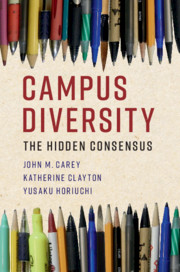Book contents
- Frontmatter
- Dedication
- Contents
- List of Figures
- List of Tables
- Preface
- 1 What We Are Studying, Why, and How
- 2 Roots of the Current Diversity Debates
- 3 Our Conjoint Experiments
- 4 What Students Think: Results across All Students
- 5 How Attitudes Differ across Groups
- 6 How Preferences Differ by Political Beliefs
- 7 What about When All Else Is Not Equal?
- 8 How Student Attitudes Differ from Faculty Attitudes
- 9 Evidence from Other Cases
- 10 What Do the Results Mean?
- Bibliography
- Index
7 - What about When All Else Is Not Equal?
Published online by Cambridge University Press: 13 December 2019
- Frontmatter
- Dedication
- Contents
- List of Figures
- List of Tables
- Preface
- 1 What We Are Studying, Why, and How
- 2 Roots of the Current Diversity Debates
- 3 Our Conjoint Experiments
- 4 What Students Think: Results across All Students
- 5 How Attitudes Differ across Groups
- 6 How Preferences Differ by Political Beliefs
- 7 What about When All Else Is Not Equal?
- 8 How Student Attitudes Differ from Faculty Attitudes
- 9 Evidence from Other Cases
- 10 What Do the Results Mean?
- Bibliography
- Index
Summary
This chapter shows that the rate of return to academic achievement (for students) or professional achievement (for faculty) does not differ across key demographic categories, by race/ethnicity or gender. That is, whites, blacks, Hispanics, Asians, and Native Americans all receive commensurate increases in likelihood of selection in our experiments for similar increases in academic achievement. Women, men, and gender non-binary faculty candidates are rewarded at commensurate rates for stronger professional achivement. The rates of return to achievement do not differ across demographic groups.
- Type
- Chapter
- Information
- Campus DiversityThe Hidden Consensus, pp. 133 - 143Publisher: Cambridge University PressPrint publication year: 2019

